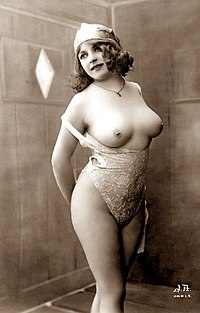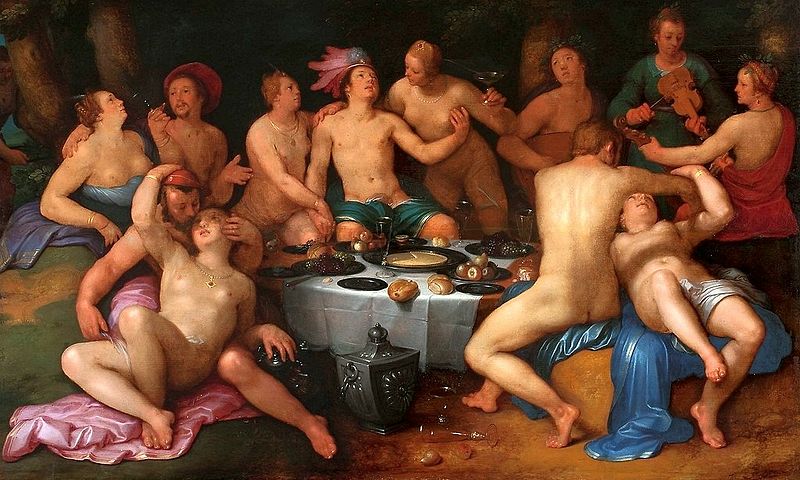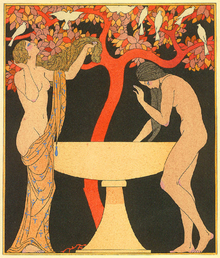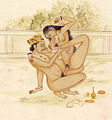Portal:Erotica and pornography
Introduction

Pornography (colloquially known as porn or porno) has been defined as sexual subject material "such as a picture, video, or text" that is intended for sexual arousal. Made for the consumption by adults, pornography depictions have evolved from cave paintings, some forty millennia ago, to virtual reality presentations. A general distinction of adult content is made classifying it as pornography or erotica.
The oldest artifacts considered pornographic were discovered in Germany in 2008 CE and are dated to be at least 35,000 years old. Throughout the history of erotic depictions, various people made attempts to suppress them under obscenity laws, censor, or make them illegal. Such grounds and even the definition of pornography have differed in various historical, cultural, and national contexts. The Indian Sanskrit text Kama Sutra (3rd century CE) contained prose, poetry, and illustrations regarding sexual behavior, and the book was celebrated; while the British English text Fanny Hill (1748), considered "the first original English prose pornography," has been one of the most prosecuted and banned books. In the late 19th century, a film by Thomas Edison that depicted a kiss was denounced as obscene in the United States, whereas Eugène Pirou's 1896 film Bedtime for the Bride was received very favorably in France. Starting from the mid-twentieth century on, societal attitudes towards sexuality became more lenient in the Western world where legal definitions of obscenity were made limited. In 1969, Blue Movie became the first film to depict unsimulated sex that received a wide theatrical release in the United States. This was followed by the "Golden Age of Porn" (1969–1984). The introduction of home video and the World Wide Web in the late 20th century led to global growth in the pornography business. Beginning in the 21st century, greater access to the Internet and affordable smartphones made pornography more mainstream. (Full article...)
Erotica is literature or art that deals substantively with subject matter that is erotic, sexually stimulating or sexually arousing. Some critics regard pornography as a type of erotica, but many consider it to be different. Erotic art may use any artistic form to depict erotic content, including painting, sculpture, drama, film or music. Erotic literature and erotic photography have become genres in their own right. Erotica also exists in a number of subgenres including gay, lesbian, women's, bondage, monster and tentacle erotica.
The term erotica is derived from the feminine form of the ancient Greek adjective: ἐρωτικός (erōtikós), from ἔρως (érōs)—words used to indicate lust, and sexual love. (Full article...)
Selected article
The term "Golden Age of Porn", or "porno chic", refers to a 15-year period (1969–1984) in commercial American pornography, in which sexually explicit films experienced positive attention from mainstream cinemas, movie critics, and the general public. This American period, which had subsequently spread internationally, and that began before the legalization of pornography in Denmark on July 1, 1969, started on June 12, 1969, with the theatrical release of the film Blue Movie directed by Andy Warhol, and, somewhat later, with the release of the 1970 film Mona produced by Bill Osco. These films were the first adult erotic films depicting explicit sex to receive wide theatrical release in the United States. Both influenced the making of films such as 1972's Deep Throat starring Linda Lovelace and directed by Gerard Damiano, Behind the Green Door starring Marilyn Chambers and directed by the Mitchell brothers, 1973's The Devil in Miss Jones also by Damiano, and 1976's The Opening of Misty Beethoven by Radley Metzger, the "crown jewel" of the Golden Age, according to award-winning author Toni Bentley. According to Andy Warhol, his Blue Movie film was a major influence in the making of Last Tango in Paris, an internationally controversial erotic drama film, starring Marlon Brando, and released in 1972, three years after Blue Movie was shown in theaters.
Following mentions by Johnny Carson on his popular Tonight Show and Bob Hope on TV as well, Deep Throat achieved major box-office success, despite being rudimentary by mainstream standards. In 1973, the more accomplished, but still low-budget, film The Devil in Miss Jones was the seventh most successful film of the year, and was well received by major media, including a favorable review by film critic Roger Ebert. The phenomenon of porn being publicly discussed by celebrities, and taken seriously by critics, a development referred to, by Ralph Blumenthal of The New York Times, as "porno chic", began for the first time in modern American culture. It became obvious that box-office returns of very low-budget adult erotic films could fund further advances in the technical and production values of porn, allowing it to compete with Hollywood films. There was concern that, left unchecked, the vast profitability of such films would lead to Hollywood being influenced by pornography.
Prior to this, thousands of U.S. state and municipal anti-obscenity laws and ordinances held that participating in the creation, distribution, or consumption of obscene films constituted criminal action. Multi-jurisdictional interpretations of obscenity made such films susceptible to prosecution and criminal liability for obscenity, thereby restricting their distribution and profit potential. Freedom in creative license, higher movie budgets and payouts, and a "Hollywood mindset" all contributed to this period. (Full article...)Selected work of erotic literature
The Songs of Bilitis (/bɪˈliːtɪs/; French: Les Chansons de Bilitis) is a collection of erotic, essentially lesbian, poetry by Pierre Louÿs published in Paris in 1894. Since Louÿs claimed that he had translated the original poetry from Ancient Greek, this work is considered a pseudotranslation. The poems were actually clever fabulations, authored by Louÿs himself, and are still considered important literature.
The poems are in the manner of Sappho; the collection's introduction claims they were found on the walls of a tomb in Cyprus, written by a woman of Ancient Greece called Bilitis (Greek: Βιλιτις), a courtesan and contemporary of Sappho's to whose life Louÿs dedicated a small section of the book. On publication, the volume deceived even expert scholars.
Louÿs claimed the 143 prose poems, excluding 3 epitaphs, were entirely the work of this ancient poet—a place where she poured both her most intimate thoughts and most public actions, from childhood innocence in Pamphylia to the loneliness and chagrin of her later years. (Full article...)Slideshow of selected contemporary images
Slideshow of selected historical images
Did you know (auto-generated) -

- ... that Christian radio station KIXL near Austin, Texas, pulled an anti-pornography program off-air in mid-transmission because of its graphic descriptions of gay sex?
- ... that Nickelodeon storyboard artists created a book with hundreds of pornographic drawings of SpongeBob SquarePants characters?
- ... that Koh Masaki was one of the first gay pornographic film actors in Japan to openly appear in adult films without obscuring his identity?
- ... that some viewers of an Arizona TV station saw hardcore pornography instead of the Super Bowl?
- ... that Jan Kochanowski's Fraszki is a 16th-century collection of almost 300 poems, ranging from anecdotes and epitaphs to obscenities and erotica?
- ... that in 2001, around 64 percent of all films produced in Malayalam were of the soft-porn variety?
- ... that according to one source, The Embroidered Couch is "most likely China's earliest vernacular pornographic novel"?
- ... that before being restored as a Broadway theater, the Ritz Theatre was used as a television studio, pornographic theater, vaudeville house, children's theater, and poster warehouse?
Topics
Categories
Related portals
Associated WikiProjects
 |
 |
| Sexology and sexuality | Pornography |
Associated Wikimedia
The following Wikimedia Foundation sister projects provide more on this subject:
-
Commons
Free media repository -
Wikibooks
Free textbooks and manuals -
Wikidata
Free knowledge base -
Wikinews
Free-content news -
Wikiquote
Collection of quotations -
Wikisource
Free-content library -
Wikiversity
Free learning tools -
Wiktionary
Dictionary and thesaurus

































































![Image 12Indian Princess, by Richard Borrmeister [de] (1888?)](http://upload.wikimedia.org/wikipedia/commons/thumb/0/01/Richard_Borrmeister_Indische_Prinzessin_1888.jpg/102px-Richard_Borrmeister_Indische_Prinzessin_1888.jpg)








































